Tomcat源码学习第3篇 - Bootstrap的启动过程
上一篇我们看了Tomcat中各个组件的init过程,初始化赋值好了,那么接下来就该轮到start了,话不多说,马上进入主题~
1. Bootstrap.start()
通过start方法我们可以看到他是通过反射调用了 Catalina.start()方法,按F7跳到这个类里面看一下。
public void start() throws Exception {
if (catalinaDaemon == null) {
init();
}
// 通过反射调用 Catalina.start() 方法
Method method = catalinaDaemon.getClass().getMethod("start", (Class [])null);
method.invoke(catalinaDaemon, (Object [])null);
}

2. Catalina.start()
进来一看,又是熟悉的套娃风格,还得继续往里面跳转

3. LifecycleBase.start()
还是这个熟悉的组件生命周期类,看到这里就仿佛看到了结局,肯定是跟initInternal这个方法一样一层层嵌套进去,让我们走起~
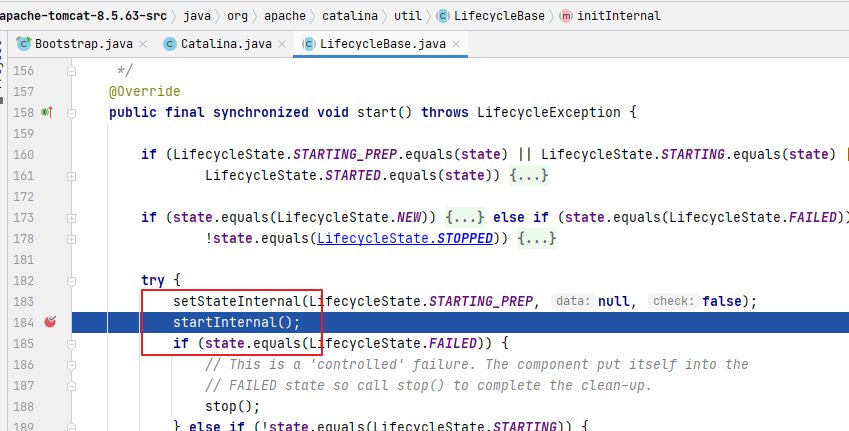
4. StandardServer.startInternal()
之前我们有说过在一个Tomcat中是可以有多个service的,所以这里需要遍历所有的service分别让各自启动起来
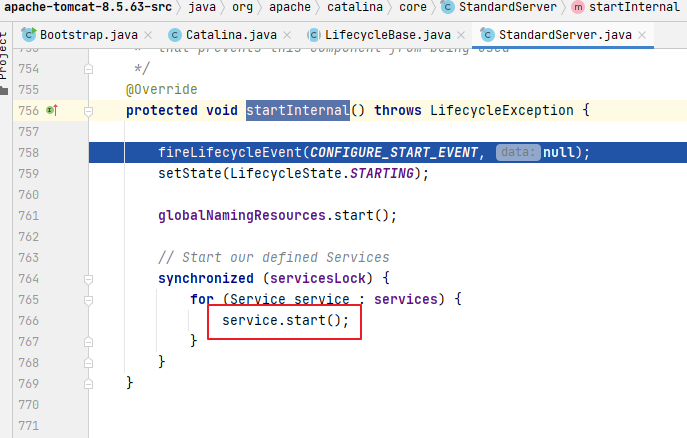
在server.xml文件中再给他配置一个<Service>标签即可,如图所示:
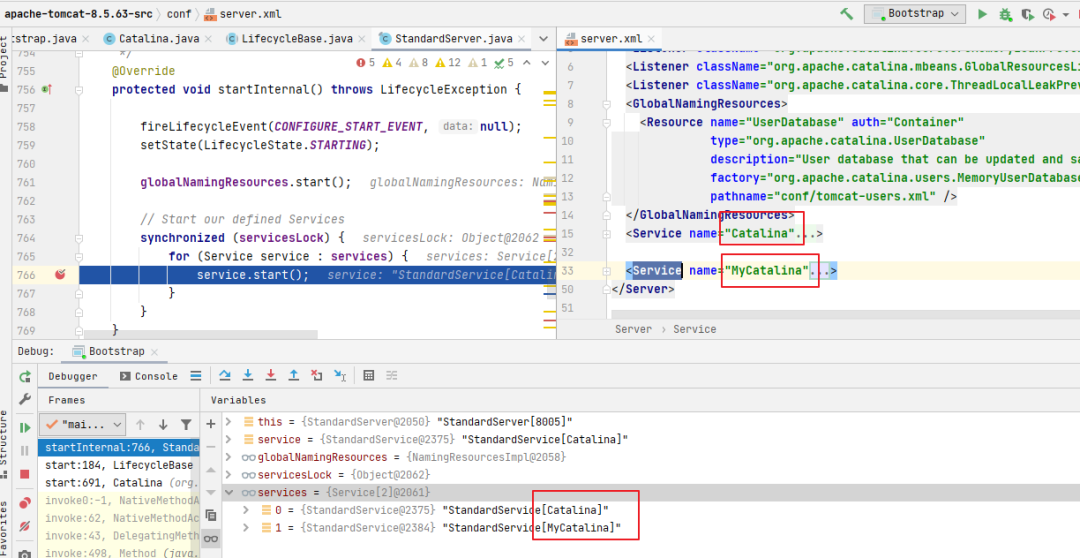
5. StandardService.startInternal()
开始进入正题了,在这个方法中我们可以看到它分别做了以下操作:
容器的启动: engine.start()连接器的启动: connector.start()
protected void startInternal() throws LifecycleException {
if(log.isInfoEnabled())
log.info(sm.getString("standardService.start.name", this.name));
setState(LifecycleState.STARTING);
// 这里首先启动我们定义的容器 engine
if (engine != null) {
synchronized (engine) {
// 启动 engine 子容器
engine.start();
}
}
synchronized (executors) {
for (Executor executor: executors) {
executor.start();
}
}
mapperListener.start();
// Start our defined Connectors second
synchronized (connectorsLock) {
for (Connector connector: connectors) {
try {
// If it has already failed, don't try and start it
if (connector.getState() != LifecycleState.FAILED) {
// 启动连接器
connector.start();
}
} catch (Exception e) {
log.error(sm.getString(
"standardService.connector.startFailed",
connector), e);
}
}
}
}
6. StandardEngine.startInternal()
这里直接调用的ContainerBase.startInternal方法实现下属组件的启动
protected synchronized void startInternal() throws LifecycleException {
// Log our server identification information
if(log.isInfoEnabled())
log.info( "Starting Servlet Engine: " + ServerInfo.getServerInfo());
// Standard container startup
super.startInternal();
}
7. ContainerBase.startInternal()
这里使用的是线程池的方式,如果有多个Host,那么就可以多个线程并行实例化Host,加快Tomcat启动速度
protected synchronized void startInternal() throws LifecycleException {
// 启动下属容器
logger = null;
getLogger();
Cluster cluster = getClusterInternal();
if (cluster instanceof Lifecycle) {
((Lifecycle) cluster).start();
}
Realm realm = getRealmInternal();
if (realm instanceof Lifecycle) {
((Lifecycle) realm).start();
}
// 查找并启动子容器,Host 在初始化阶段后还是不完整的,需要继续封装,把容器关系维护完整
Container children[] = findChildren();
List<Future<Void>> results = new ArrayList<>();
for (Container child : children) {
results.add(startStopExecutor.submit(new StartChild(child)));
}
MultiThrowable multiThrowable = null;
for (Future<Void> result : results) {
try {
result.get();
} catch (Throwable e) {
log.error(sm.getString("containerBase.threadedStartFailed"), e);
if (multiThrowable == null) {
multiThrowable = new MultiThrowable();
}
multiThrowable.add(e);
}
}
if (multiThrowable != null) {
throw new LifecycleException(sm.getString("containerBase.threadedStartFailed"),
multiThrowable.getThrowable());
}
// Start the Valves in our pipeline (including the basic), if any
if (pipeline instanceof Lifecycle) {
((Lifecycle) pipeline).start();
}
// 设置容器生命周期状态
setState(LifecycleState.STARTING);
// Start our thread
threadStart();
}
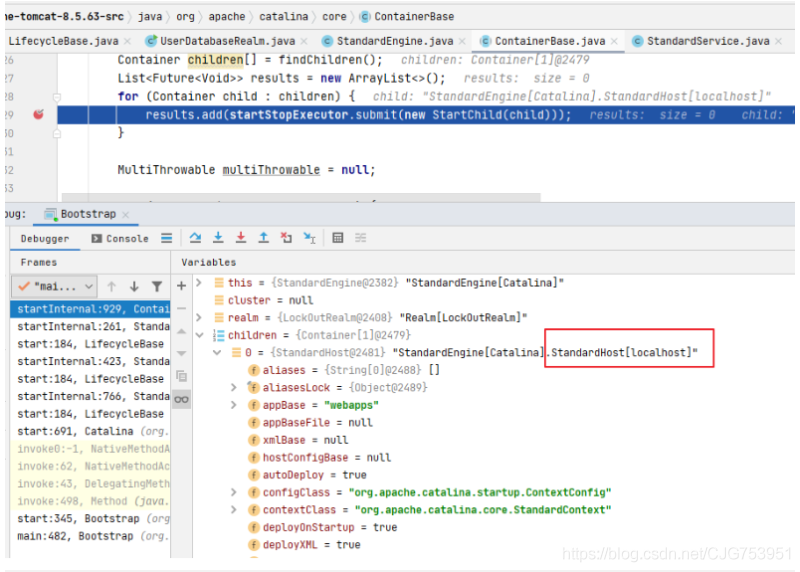

8. StandardHost.startInternal()
protected synchronized void startInternal() throws LifecycleException {
// Set error report valve
String errorValve = getErrorReportValveClass();
if ((errorValve != null) && (!errorValve.equals(""))) {
try {
boolean found = false;
Valve[] valves = getPipeline().getValves();
for (Valve valve : valves) {
if (errorValve.equals(valve.getClass().getName())) {
found = true;
break;
}
}
if(!found) {
Valve valve =
(Valve) Class.forName(errorValve).getConstructor().newInstance();
getPipeline().addValve(valve);
}
} catch (Throwable t) {
ExceptionUtils.handleThrowable(t);
log.error(sm.getString(
"standardHost.invalidErrorReportValveClass",
errorValve), t);
}
}
super.startInternal();
}
Host的实例化,是通过设置生命周期状态来进行促发生命周期事件fireLifecycleEvent来执行后续工作的。
deployApps:处理host下多个应用deployDirectories:处理host下面以目录方式部署的(results.add(),这里也是以多线程的方式并行执行的)host.addChild():这时才触发context实例核心内容context:具体读取web.xml封装wrapper过程使用事件驱动交给ContextConfig(它也是一个事件监听器)
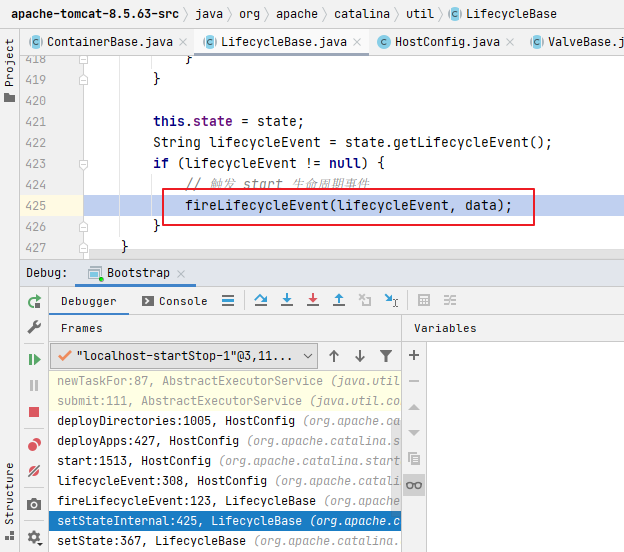



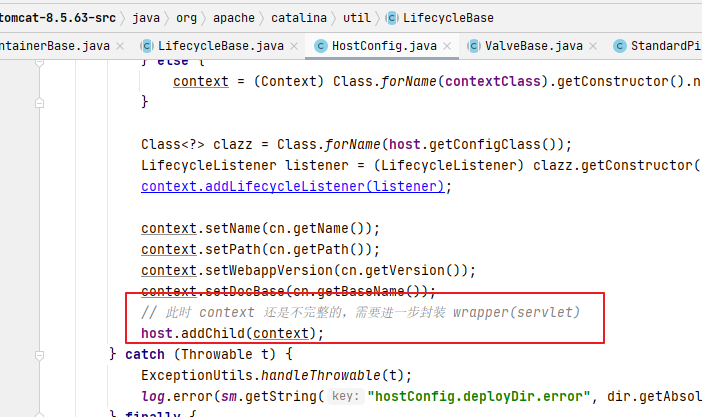
9. MapperListener.startInternal()
public void startInternal() throws LifecycleException {
setState(LifecycleState.STARTING);
// 得到 engine 容器
Engine engine = service.getContainer();
if (engine == null) {
return;
}
// 找到默认主机
findDefaultHost();
// 为当前容器以及子容器添加监听器
addListeners(engine);
// 注册engine下所有的host
Container[] conHosts = engine.findChildren();
for (Container conHost : conHosts) {
Host host = (Host) conHost;
if (!LifecycleState.NEW.equals(host.getState())) {
// 注册上下文和包装器
registerHost(host);
}
}
}
10. Connector.startInternal()
截至到这里,容器的注册与启动已经完成了,接下来到连接器的启动了
protected void startInternal() throws LifecycleException {
// Validate settings before starting
if (getPort() < 0) {
throw new LifecycleException(sm.getString(
"coyoteConnector.invalidPort", Integer.valueOf(getPort())));
}
setState(LifecycleState.STARTING);
try {
protocolHandler.start();
} catch (Exception e) {
throw new LifecycleException(
sm.getString("coyoteConnector.protocolHandlerStartFailed"), e);
}
}
11. AbstractProtocol.start()
这里对 EndPoint进行初始化
public void start() throws Exception {
if (getLog().isInfoEnabled()) {
getLog().info(sm.getString("abstractProtocolHandler.start", getName()));
}
endpoint.start();
// Start timeout thread
asyncTimeout = new AsyncTimeout();
Thread timeoutThread = new Thread(asyncTimeout, getNameInternal() + "-AsyncTimeout");
int priority = endpoint.getThreadPriority();
if (priority < Thread.MIN_PRIORITY || priority > Thread.MAX_PRIORITY) {
priority = Thread.NORM_PRIORITY;
}
timeoutThread.setPriority(priority);
timeoutThread.setDaemon(true);
timeoutThread.start();
}

12. AbstractEndpoint.start()
public final void start() throws Exception {
if (bindState == BindState.UNBOUND) {
bind();
bindState = BindState.BOUND_ON_START;
}
startInternal();
}
13. NioEndpoint.bind()
public void bind() throws Exception {
if (!getUseInheritedChannel()) {
// 获取 nio 通道 channel
serverSock = ServerSocketChannel.open();
socketProperties.setProperties(serverSock.socket());
InetSocketAddress addr = (getAddress()!=null?new InetSocketAddress(getAddress(),getPort()):new InetSocketAddress(getPort()));
// 绑定端口,但尚未使用 accept 获取客户端连接
serverSock.socket().bind(addr,getAcceptCount());
} else {
// Retrieve the channel provided by the OS
Channel ic = System.inheritedChannel();
if (ic instanceof ServerSocketChannel) {
serverSock = (ServerSocketChannel) ic;
}
if (serverSock == null) {
throw new IllegalArgumentException(sm.getString("endpoint.init.bind.inherited"));
}
}
serverSock.configureBlocking(true); //mimic APR behavior
// Initialize thread count defaults for acceptor, poller
if (acceptorThreadCount == 0) {
// FIXME: Doesn't seem to work that well with multiple accept threads
acceptorThreadCount = 1;
}
if (pollerThreadCount <= 0) {
//minimum one poller thread
pollerThreadCount = 1;
}
setStopLatch(new CountDownLatch(pollerThreadCount));
// Initialize SSL if needed
initialiseSsl();
selectorPool.open();
}
14. NioEndpoint.startInternal()
这里通过startAcceptorThreads启动Accepter线程,该线程用于接收新的Socket连接



总结

评论
